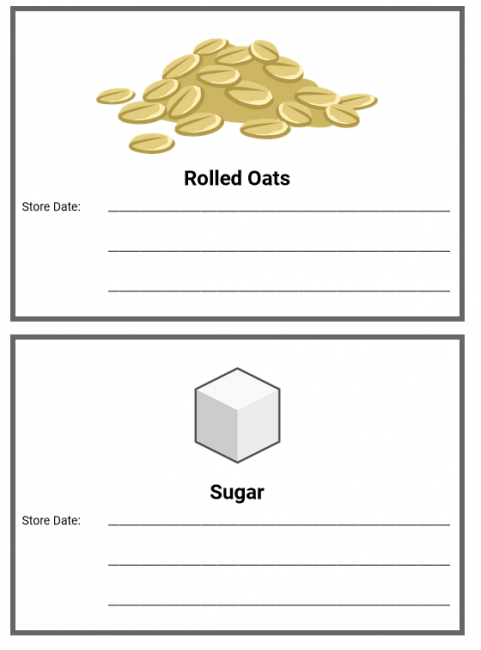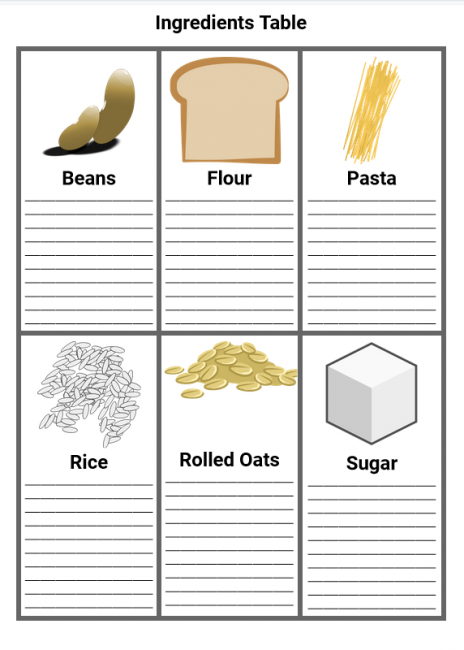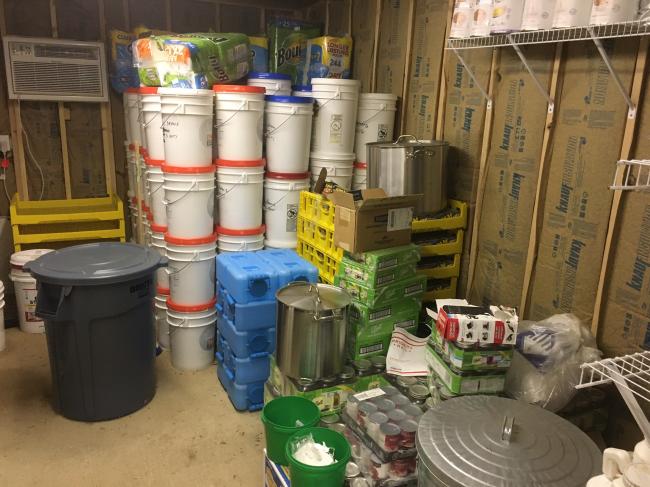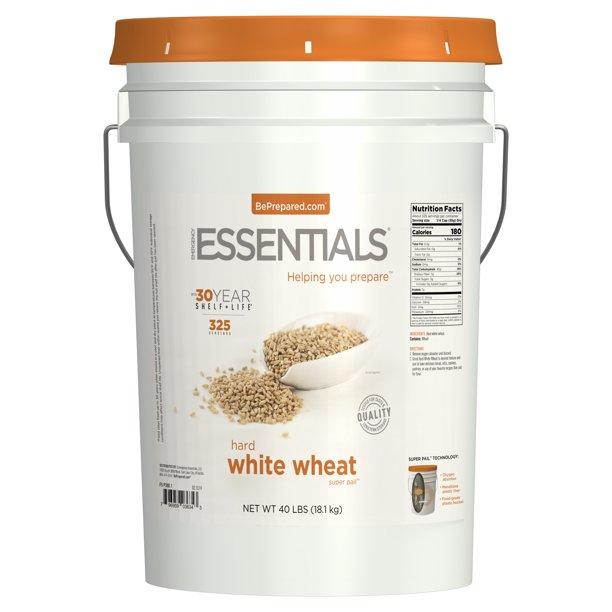How do you label your food storage buckets?
If you’re storing long-term food or staples in airtight containers and 5-gallon buckets, how do you label them? How do you tell which containers hold which food?
For a long while I have been using masking tape and a sharpie – just write the food type and storage date on the tape, and apply new tape as needed. I see some previous threads on this too.
But recently I thought it would be nice to have a more visual element – adding some easy-to-recognize icons and shapes.
I created a quick document using public domain graphics to print icons for different types of food – you can find it here.
https://docs.google.com/document/d/1Hwm0QAT6t3cCjPS1GJ-C3rswFoq1r-Zcw04ZBzApCAM/
Please feel free to copy, edit, or share.
I would love to hear if anyone else does something like this, or if you find this useful.
-
Comments (15)
-
Henry Tubbs - March 19, 2022
We’ve always just written on the bucket with a sharpie what it is and the expiration date to know when to rotate. I like the visuals of the pictures and nice uniform labels. Next time I need to label a bucket I will print these off and adopt them, so thank you for sharing.
What would look nice would be to get some of those clear plastic sheet protectors that you put in a binder and tape that onto the bucket. You then can slip whatever sheet you want into the sheet protector. If you need to change out what you store in there or update a label you can.
Another thought I just had is that the pictures could help identify what is in there if you didn’t have your reading glasses on you for small text, children could identify the food in there more easily, and it would be helpful if you were trading or giving away the food to someone who spoke another language.
-
brownfox-ffContributor - March 20, 2022
>What would look nice would be to get some of those clear plastic sheet protectors that you put in a binder and tape that onto the bucket.
Hey, now that is a slick idea.
>if you didn’t have your reading glasses
>children or people who can’t read
>different languagesYes, great points – all of these cases sound helpful.
Thanks, this has given me more to think on. I’m happy if it’s useful, and good luck organizing.
-
-
Bigwig - March 20, 2022
How about taking a photo before sealing it up and taping it to the bucket? It can double as a verification of what it looked like when you stored it versus when you open it.
Also, it would be interesting to put the details of the product purchased, size/weight, date of purchase, best buy date, cost, and place of purchase. This might help in case there are any recalls.
-
brownfox-ffContributor - March 20, 2022
Taking photos is a neat strategy. For me I like to have something “offline” that doesn’t require electronics, power, or internet. But photos could be a good reminder or main system.
If the technique works for you – great!
-
-
RedneckContributor - March 20, 2022
I don’t see the need for anything beyond a sharpie for long term food stores. I’m talking foods that can store for 25-30 years. For me that includes, wheat berries (not flour), rolled oats, white rice, dried beans, dried pasta, sugar, table salt, curing salts, etc. I simply write on the bucket the food inside & the date packaged.
If someone needs a picture to figure out what’s inside or when it was packed, then I’m afraid they are too stupid to survive anyway. 🙂
-
Liz Klein - March 20, 2022
I don’t think brownfox needs the pictures, but it’s a creative way that they want to organize their supplies. For you a sharpie works, for others they want to use labels or pictures. It’s just great that people are doing things and making progress! I love to see how everyone does things and what works and doesn’t work for them.
-
brownfox-ffContributor - March 20, 2022
Redneck thanks for sharing – I am envious of your amazing storage. This is inspiring that I can work toward something like this. Nice work.
Yes, as Liz comments below – I am not saying that I _need_ the pictures. I just like trying to be organized. For me, images are a quick way to easily recall and identify. Whatever systems works for each person – great!
-
RedneckContributor - March 20, 2022
My pails are actually organized. Each row of pails, headed out to the center aisle, is one food item. So for example, all 20 pales in the row closest to the camera are dried beans. I have 2 rows worth of wheat berries, which is 40 pales. There are other pales on the other side of the center aisle.
And yes, with long term food stores, it is something you can work on slowly. Most of my pails contain food items I bought at Costco or Sam’s, and sealed up myself. That is the cheapest way to put up large amounts of food. Now wheat berries aren’t something I could source locally, so I purchased these from Walmart online with free freight… back when they were cheap and readily available.
-
M. E.Contributor - March 22, 2022
I had a family member who suffered a head injury (a likely circumstance in an earthquake, tornado, or other disaster where things are falling on you) and had extensive difficulty reading afterward. I also know of older folks with early onset dementia who have trouble reading.
Pictures on the pails could be immensely helpful and can’t hurt. It’s easy to assume we will have all of our faculties in the future but providing a variety of ways to understand something (pictures, large text, etc.) can be a kindness both to others and to yourself.
-
-
Barb LeeContributor - March 20, 2022
I keep a pretty detailed inventory of my stores, which includes their location. All my buckets are numbered, and I can glance at my spreadsheet and see what each contains. For instance, Bucket #6 contains vacuum sealed dehydrated green beans, dehydrated corn, dehydrated onions, dehydrated peas and dehydrated tomatoes. Baked beans are on the “New Metal Shelf” (to distinguish from the Old Metal Shelf!), Box 3. As long as my entries are accurate (not always the case) I can make a shopping list, take it down to the cellar and know exactly where to look. Kind of like going to Home Depot online and finding out which aisle and bin your stuff is in before you leave home to go to the store.
-
Liz Klein - March 20, 2022
I love your organization, that’s very impressive. I do the same thing and distinguish shelves by old/new. Pretty funny that people think alike
-
brownfox-ffContributor - March 20, 2022
Ahh, very nice. I like the idea of browsing a master list to scan over what you have. Kudos.
I suppose if you are storing foods for a longer period – 25 years – then you don’t need to update the spreadsheet as often.
-
Barb LeeContributor - March 20, 2022
At my age, I don’t have an expected lifespan of 25 years! LOL! I have some FD food items, but the bulk of the supply is “buy what you eat, eat what you buy”. Over time, I may have enough food in storage to last a year, but the storage is a fairly young work in progress, so it’s pretty important for me to be able rotate the inventory and USE it. The spreadsheet allows me to sort by any column, so once a month I sort by the “Best By” date, which insures that I actually do use everything on a timely basis. It also helps me correct my errors.
-
Barb LeeContributor - March 20, 2022
The reason I feel such an inventory would be a benefit to me as the manager of this end of our preps, is because I estimate I have a mere 3-6 months worth of food and personal hygiene items on hand and the inventory presently contains 431 line items. These are not all unique items, but entries made when the particular items were purchased, so their location (which may be different than same items purchased earlier) and best by dates can be recorded. That’s enough spare parts to keep track of to run some small businesses, so it ought to be managed the same way. When I had a small business, I used to pay income taxes every year on the same unused parts I’d kept in inventory for 14 years. That is bad inventory management.
-
-
wildfireexpert - March 21, 2022
Sharpie and the date in addition to what may already exist on the long-term storage pails.
-
- News for the week of 2025-07-07 - 5 days ago
- Fun ways to teach kids outdoor/survival skills - 2 weeks ago
- News for the week of 2025-06-30 - 2 weeks ago
- News for the week of 2025-06-23 - 3 weeks ago
- News for the week of 2025-06-16 - 3 weeks ago
This forum is heavily moderated to keep things valuable to as many people as possible. Full community policies are here. The basics:
- 1. Be nice to each other.
- 2. Stay focused on prepping.
- 3. Avoid politics, religion, and other arguments.
- 4. No unfounded conspiracies, fake news, etc.
- 5. Debate ideas, not people.



